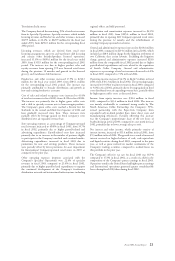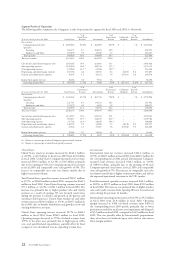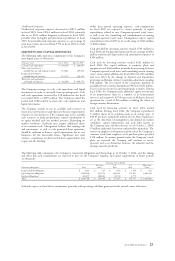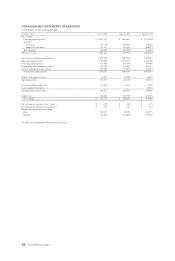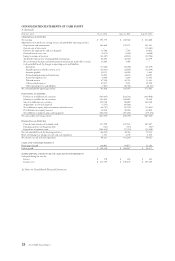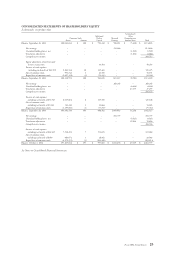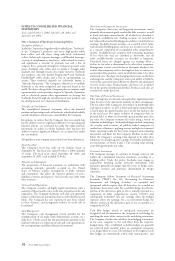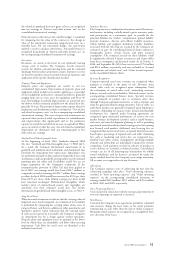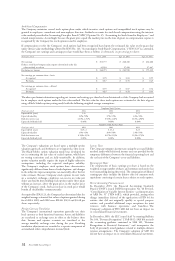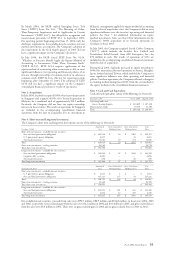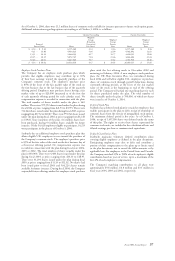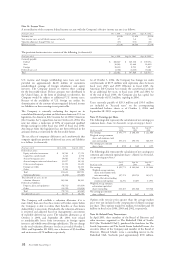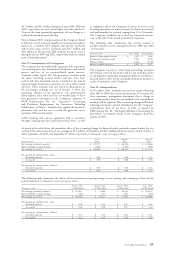Starbucks 2004 Annual Report Download - page 20
Download and view the complete annual report
Please find page 20 of the 2004 Starbucks annual report below. You can navigate through the pages in the report by either clicking on the pages listed below, or by using the keyword search tool below to find specific information within the annual report.Fiscal 2004 Annual Report 31
the related accumulated derivative gains or losses are recognized
into net earnings in “Interest and other income, net” on the
consolidated statements of earnings.
Forward contract effectiveness for cash fl ow hedges is calculated
by comparing the fair value of the contract to the change in
value of the anticipated transaction using forward rates on a
monthly basis. For net investment hedges, the spot-to-spot
method is used to calculate effectiveness. Any ineffectiveness is
recognized immediately in “Interest and other income, net” on
the accompanying consolidated statements of earnings.
Inventories
Inventories are stated at the lower of cost (primarily moving
average cost) or market. The Company records inventory
reserves for obsolete and slow-moving items and for estimated
shrinkage between physical inventory counts. Inventory reserves
are based on inventory turnover trends, historical experience and
application of the specifi c identifi cation method.
Property, Plant and Equipment
Property, plant and equipment are carried at cost less
accumulated depreciation. Depreciation of property, plant and
equipment, which includes assets under capital leases, is provided
on the straight-line method over estimated useful lives, generally
ranging from two to seven years for equipment and 30 to 40
years for buildings. Leasehold improvements are amortized over
the shorter of their estimated useful lives or the related lease life,
generally 10 years. The portion of depreciation expense related to
production and distribution facilities is included in “Cost of sales
and related occupancy costs” on the accompanying consolidated
statements of earnings. The costs of repairs and maintenance are
expensed when incurred, while expenditures for refurbishments
and improvements that signifi cantly add to the productive
capacity or extend the useful life of an asset are capitalized. When
assets are retired or sold, the asset cost and related accumulated
depreciation are eliminated with any remaining gain or loss
refl ected in net earnings.
Goodwill and Other Intangible Assets
At the beginning of fi scal 2003, Starbucks adopted SFAS
No. 142, “Goodwill and Other Intangible Assets” (“SFAS 142”).
As a result, the Company discontinued amortization of its
goodwill and indefi nite-lived trademarks and determined that
provisions for impairment were unnecessary. Impairment tests
are performed annually in June and more frequently if facts and
circumstances indicate goodwill carrying values exceed estimated
reporting unit fair values and if indefi nite useful lives are no
longer appropriate for the Company’s trademarks. If the
nonamortization provision of SFAS 142 had been applied to
fi scal 2002, net earnings would have been $214.7 million, as
compared to actual net earnings of $212.7 million. Basic earnings
per share for fi scal 2002 would have increased to $0.56 per share
from $0.55 per share, while diluted earnings per share would
have remained unchanged. Defi nite-lived intangibles, which
mainly consist of contract-based patents and copyrights, are
amortized over their estimated useful lives. For further
information on goodwill and other intangible assets, see Note 9.
Long-Lived Assets
When facts and circumstances indicate that the carrying values of
long-lived assets may be impaired, an evaluation of recoverability
is performed by comparing the carrying values of the assets to
projected future cash fl ows in addition to other quantitative and
qualitative analyses. Upon indication that the carrying values
of such assets may not be recoverable, the Company recognizes
an impairment loss by a charge against current operations.
Property, plant and equipment assets are grouped at the lowest
level for which there are identifi able cash fl ows when assessing
impairment. Cash fl ows for retail assets are identifi ed at the
individual store level.
Insurance Reserves
The Company uses a combination of insurance and self-insurance
mechanisms, including a wholly owned captive insurance entity
and participation in a reinsurance pool, to provide for the
potential liabilities for workers’ compensation, general liability,
property insurance, director and offi cers’ liability insurance,
vehicle liability and employee healthcare benefi ts. Liabilities
associated with the risks that are retained by the Company are
estimated, in part, by considering historical claims experience,
demographic factors, severity factors and other actuarial
assumptions. The estimated accruals for these liabilities could
be signifi cantly affected if future occurrences and claims differ
from these assumptions and historical trends. As of October 3,
2004, and September 28, 2003, these reserves were $77.6 million
and $51.6 million, respectively, and were included in “Accrued
compensation and related costs” and “Other accrued expenses”
on the consolidated balance sheets.
Revenue Recognition
Company-operated retail store revenues are recognized when
payment is tendered at the point of sale. Revenues from
stored value cards are recognized upon redemption. Until
the redemption of stored value cards, outstanding customer
balances on such cards are included in “Deferred revenue” on the
accompanying consolidated balance sheets. Specialty revenues
consist primarily of product sales to customers other than
through Company-operated retail stores, as well as royalties and
other fees generated from licensing operations. Sales of coffee, tea
and related products are generally recognized upon shipment to
customers, depending on contract terms. Initial nonrefundable
development fees required under licensing agreements are
recognized upon substantial performance of services for new
market business development activities, such as initial business,
real estate and store development planning, as well as providing
operational materials and functional training courses for opening
new licensed retail markets. Additional store licensing fees are
recognized when new licensed stores are opened. Royalty revenues
based upon a percentage of reported sales and other continuing
fees, such as marketing and service fees, are recognized on a
monthly basis when earned. Arrangements involving multiple
elements and deliverables are individually evaluated for revenue
recognition. Cash payments received in advance of product or
service delivery are recorded as deferred revenue. Consolidated
revenues are net of all intercompany eliminations for wholly
owned subsidiaries and for licensees accounted for under the
equity method based on the Company’s percentage ownership.
All revenues are recognized net of any discounts.
Advertising
The Company expenses costs of advertising the fi rst time the
advertising campaign takes place. Total advertising expenses,
recorded in “Store operating expenses” and “Other operating
expenses” on the accompanying consolidated statements of
earnings totaled $68.3 million, $49.5 million and $25.6 million
in 2004, 2003 and 2002, respectively.
Store Preopening Expenses
Costs incurred in connection with the start-up and promotion of
new store openings are expensed as incurred.
Rent Expense
Certain of the Company’s lease agreements provide for scheduled
rent increases during the lease terms or for rental payments
commencing at a date other than the date of initial occupancy.
Minimum rental expenses are recognized on a straight-line basis
over the terms of the leases.


